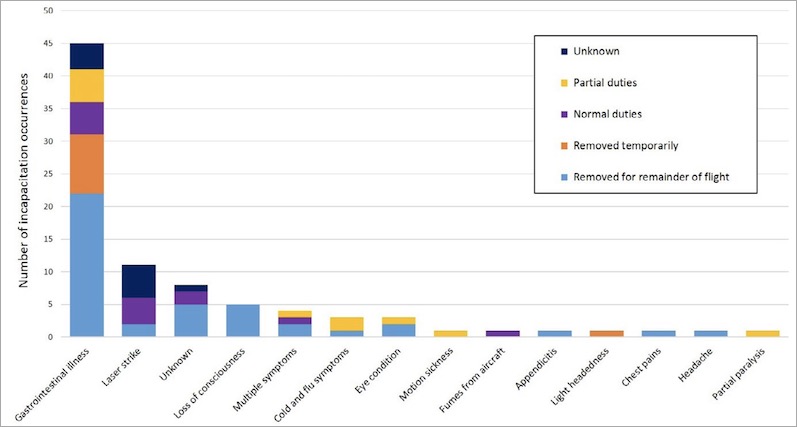Home
A comprehensive resource for safe and responsible laser use

2016 Australian Transport Safety Bureau pilot incapacitation study
A February 2016 study by the Australian Transport Safety Bureau found that from 2010 to 2014, laser strikes were the second leading cause of flight crew incapacitations, after gastrointestinal illnesses.
There were 113 flight crew incapacitations in Australia during the study period — an average of about 23 per year. Of these, 15 (13.3%) of the reported incapacitations were due to laser strikes.
The ATSB study did not give a specific definition of “incapacitation”. In the bar chart below, after some incapacitation incidents a pilot was able to resume normal duties so it did not seem to affect the flight.
The study looked at “high-capacity” and “low-capacity” air transport, as well as general aviation.
High-capacity air transport statistics
There were 86 reported incapacitations for high-capacity air transport, defined as aircraft with more than 38 seats or a payload capacity over 4,200 kg. Forty-five incapacitations were from gastrointestinal illness, eleven from a laser strike, followed by eight “unknown," five loss of consciousness, and a variety of other ailments including cold and flu, eye condition, and motion sickness.
ATSB noted “With multi-pilot crews in high capacity operations, these occurrences usually had minimal effect on the flight.” Specifically for the 11 laser strikes, there were two cases where the pilot was removed from duties for the remainder of the flight, four cases where the pilot resumed normal duties, and five cases where the impact on the flight duties was unknown.
During the study period, there were approximately 2,924,000 high-capacity air transport operations, with 86 reported incapacitations. The overall rate of incapacitation, then, was about 1 in every 34,000 high-capacity flights.
Also during the study period, there were 1,316 laser strikes reported to the ATSB in high-capacity operations; this is about 1 laser strike in every 2,222 high-capacity flights.
Of the 1,316 laser strikes, eleven (0.8%) resulted in flight crew incapacitation, this is about 1 incapacitation from a laser strike for every 265,800 high-capacity flights.
The bar chart below shows causes of incapacitation, and any impact on the flight duties.

Figure 1 in the ATSB study: “Causes of pilot incapacitation and resultant duty restrictions in high-capacity transport operations, 2010 to 2014”
The ATSB study gave this account of a laser strike: “During the climb from Sydney, a green laser was pointed at an Embraer ERJ 170. The first officer, who was pilot flying at the time, saw the laser and reported that they had impaired vision. The captain then assumed flying responsibilities for the remainder of the flight to Canberra. After landing, the first officer went to hospital for an eye examination (ATSB occurrence 201105659).”
Low-capacity air transport statistics
For low-capacity air transports, there were 12 reported incapacitations. Four were from gastrointestinal illness, followed by one each from causes such as laser strike, illicit drugs, hypoxia and unknown.
The one reported low-capacity air transport laser strike incapacitation did not affect the flight crew’s normal duties. This is the account: “During approach into Bairnsdale from Essendon, Victoria, the crew of a Beechcraft Super King Air B200 conducting a medical transport flight reported two green lasers directed at the aircraft. The pilot reported that their vision was affected and considered conducting a missed approach, but then recovered enough to continue (ATSB occurrence 201002031).”
General aviation air transport statistics
For general aviation, there were 15 reported incapacitations. The leading cause was laser strikes, with four occurrences. Others included loss of consciousness, heart attack, and microsleep. Interestingly, gastrointestinal illness was not listed.
Eleven of the 15 general aviation incapacitations had an effect on flight operations, ranging from returning to the departure airport, to collision with terrain.
The study gave accounts of all four general aviation laser strikes:
- During cruise, the pilot of a Bell 206B helicopter reported a green laser aimed at the helicopter near Caloundra, Queensland. One pilot reported their vision was momentarily affected by the laser and the other reported no incapacitation (ATSB occurrence 201303882).
- During initial climb, the pilot of a Piper PA-28 Archer aircraft conducting night circuits at Moorabbin, Victoria was struck by a green laser in the right eye, momentarily blinding them (ATSB occurrence 201006939).
- While conducting aerial work near Brisbane, Queensland, a Eurocopter AS350 was struck by a green laser which temporarily blinded the pilot. The aircraft then left the area so the pilot could regain their vision and visual reference point. Once the helicopter returned to the area, they were struck again by the laser, causing further difficulties regaining visual reference. This continued for 10 minutes until the helicopter left the area (ATSB occurrence 201103594).
- During aerial work in Jandakot, Western Australia, a green laser struck the pilot of a Cessna 172RG Skyhawk who was momentarily incapacitated (ATSB occurrence 201408503).
Recommendations for dealing with laser incapacitation
The ATSB study referenced U.S. Federal Aviation Administration recommendations for how pilots can minimize the effects of laser strike. The steps in brief are: Anticipate, aviate, navigate, communicate, illuminate (turn up cockpit lights), delegate, attenuate, do not exacerbate (avoid rubbing eyes), evaluate (if symptoms persist, see an eye doctor).
The study also noted that emergency training was important. They referenced an incident where a pilot had completed once-every-18-months training for incapacitation about 3 months prior to an incident. The captain involved “reported the training had greatly assisted with their response to the incident.”
(Incidentally, in the “lessons learned” for gastrointestinal illness, the study said “The practice of ensuring all pilots on the same flight eat different meals prior to and during the flight has been an effective defence preventing all pilots on the same flight becoming incapacitated at the same time.”)
From “Pilot incapacitation occurrences 2010-2014,” Australian Transport Safety Bureau, Report No. AR-2015-096, published 18 February 2016. Available online from ATSB or from a local copy here at LaserPointerSafety.com.